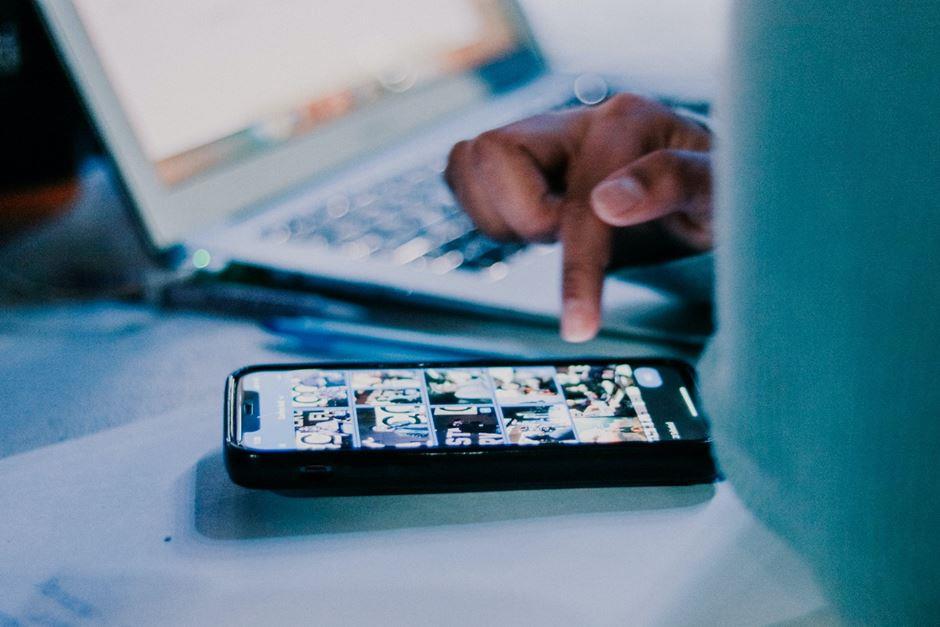
https://unsplash.com/photos/x3zXiLFIfIs
Introduction
Influencers are the marketing strategy of the 21st century. Out of all possible traditional and digital marketing channels and strategies, influencers now boast the most impressive statistics and performance of all. Here are some stats that illustrate the power of influencer marketing:
- almost 1 in 5 companies spend more than half of their marketing budget on influencer campaigns (Source: BigCommerce)
- on average, businesses make $5.2 for every $1 spent on influencer campaigns (Source: Influencer Marketing Hub)
- 70% of teens said they trust influencers more than celebrities, while 4 out of 10 millennials say that their favourite influencers understand them better than their own friends (Source: Digital Marketing Institute)
- half of Twitter users say they have made a purchase in the past based on a Tweet (Source: Twitter)
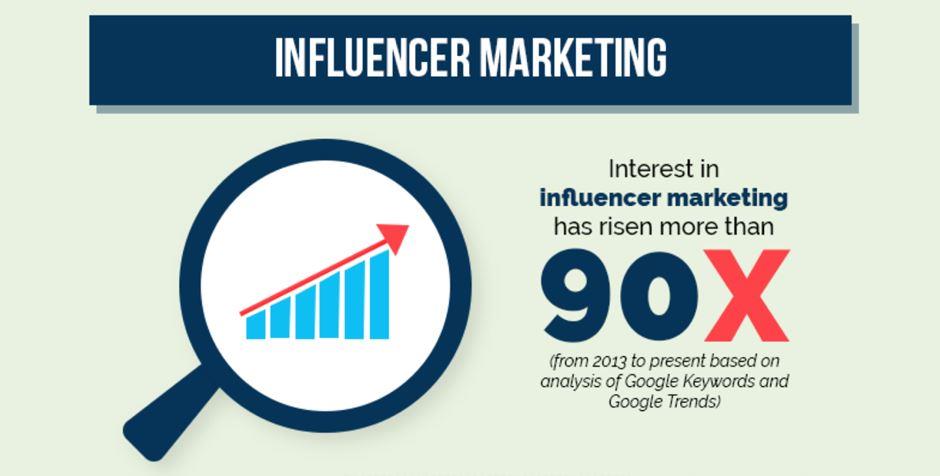
Image source: HostPapa
Types of Influencers
Before you start drafting your campaign, you also need to be aware that there are different categories of influencers.
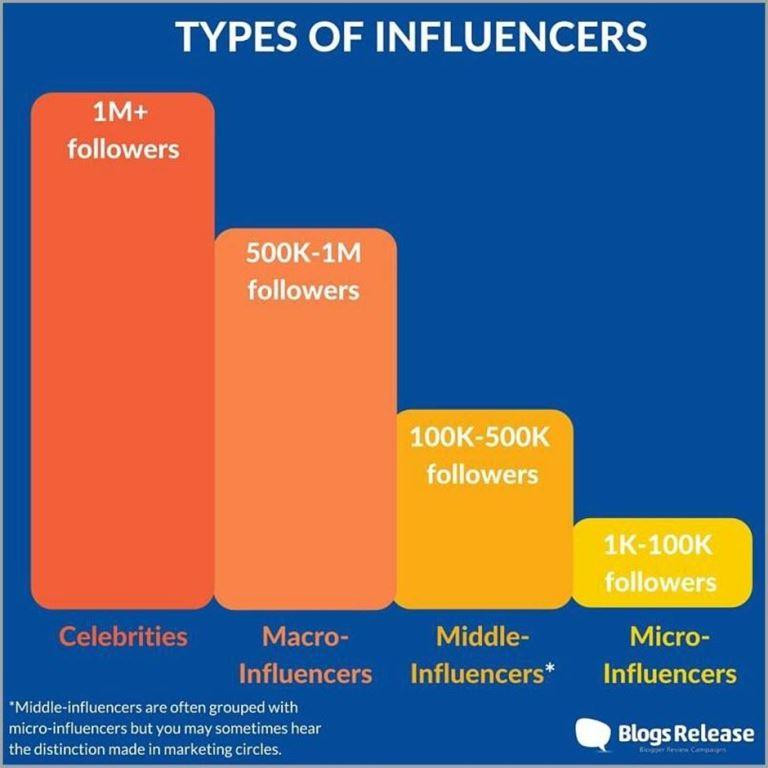
Image source: Jeffbullas
According to size, influencers are usually grouped in four (4) categories:
- micro-influencers: with 1k-100k followers
- middle-influencers: with 100k-500k followers
- macro-influencers: with 500k-1m followers
- celebrities and mega-influencers: with over a million followers
There are also different categorizations available online and among experts. Also, these numbers are shifting as time goes by and consumer behaviour changes. Interestingly, the category that isn’t mentioned in this division – nano-influencers – attracted a lot of interest in 2024. Namely, brands have discovered that influencers with a thousand or so followers have a much higher engagement rate than bigger influencers.
There are also more complex categorizations of influencers based on type and function of their page, like this one:
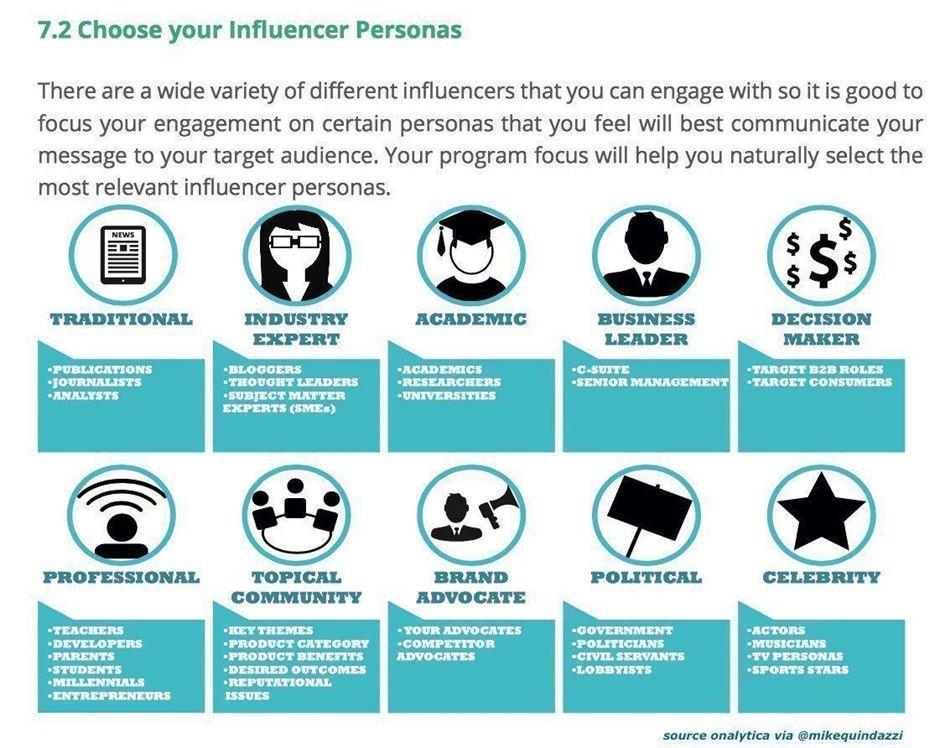
Image source: Twitter
As you can see, you can place your ideal influencer persona into one of these categories, depending on your industry and target audience.
How to Find the Top Influencers for Your Brand?
As we have already mentioned, it’s not implied that it’s “the bigger, the better” when it comes to influencer marketing. For many brands and industries, micro influencers produce a higher ROI than macro-influencers. Also, there’s a pressing issue of purchasing likes and followers. Many websites provide bot followers for a cheap rate, which means that practically anyone can have tens of thousands of followers for just a couple of hundred of dollars.
This, in turn, allows them to charge for influencer campaign services, but you will get very little in return when you work with them, because their audience is not organic. Therefore, you need to pay attention to a profile’s engagement rate, and not just their follower count.
Now, for every brand, the list of ideal influencers will be different, but some will overlap. Let’s start looking at the steps that you need to take to start running a successful influencer campaign:
1) Identify your ideal influencer persona
The first step towards a successful marketing campaign with influencers is to determine the exact type you are looking for. This is directly correlated to your target audience and your brand policies, which is why you will need to have these things ready by the time you start building influencer personas.
An influencer persona allows you to compose a list of potential collaborators more quickly and easily. Also, if several people start working on composing your mailing list (which is the next step that we will cover), they will know exactly the type of person to look for. It’s like a brand guide, but for promotional partners.
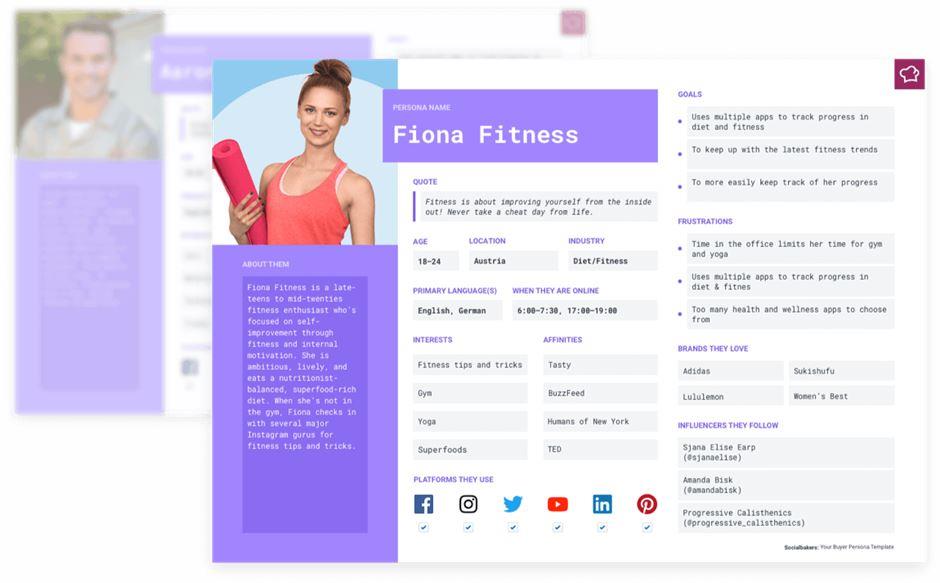
Image source: SocialBakers
Let’s take a look at the example above, which is a great illustration of a well-developed influencer persona. Here are some things that you can define to help you get the best results:
- Age
When you select an age range for your influencers, it’s very similar to choosing an age range for your target audience. In many cases, influencers have followers that are close to their age (of course, there are exceptions). Consider whether this is something that’s important for your brand or whether and age group could be a successful promoter. For example, a fitness brand will usually seek an influencer in the age group of 18-31, while book review influencers can easily be 20 or 60, it doesn’t really matter.
- Location
Location is another factor that could be important. For example, if one of your goals is to attract people into your physical store or service location, it’s definitely recommended that you narrow down influencers that are close to your location. In other cases, where you are targeting a global audience, you can choose influencers from anywhere in the world. Generally speaking, you can start with your home market if this is your first time working with influencers in order to get a better picture of what the process looks like. Then, you can continue expanding to other countries, regions and globally.
- Industry
You should choose influencers that are relevant in your industry or a supporting industry. Of course, your core influencers (the ones you set aside the biggest budget for) should be in your niche. If you’re feeling creative and you want to run an out-of-the-box influencer campaign, you can even cross-market your brand or products with an influencer from an entirely different industry. For example, as a fitness supplement brand, you can partner up with someone from the IT domain who will promote from an angle of maintaining health and fitness for people working on their computer.
- Platforms they use
Before continuing with your influencer journey, you need to decide whether you want them to promote your brand across all their channels or just one. In many cases, brands decide to go with Instagram only. This is because Instagram is considered the Mecca of influencer marketing. If you want someone who will promote on other networks like, for example, LinkedIn or YouTube, make sure to include that in your ideal influencer persona.
- The number of followers
Just like we have previously mentioned, it’s important to determine whether you will work with nano, micro, macro or mega influencers (keep in mind that mega and celebrity influencers campaigns might cost up to a million dollars per post).
According to Influencer Marketing Hub, you will have to set aside this much money per post for an influencer in 2024:
- Nano-influencers: from $10 – $100
- micro-influencers: from $100 – $500
- macro-influencers: from $5,000 – $10,000
2) Create a list with influencers you’re going to reach out to
Now, after you have defined your ideal influencer persona, you have an exact blueprint on the type of people you’re going to connect with. To compile your list, you can obviously use social media, but there are also influencer search platforms where you can enter your requirement and see who fits your needs.
For example, on Social Bakers, you can find influencers based on their location and interests. There are also tools that you can use to filter and narrow down influencers even more according to your campaign requirements.
Open a sheet and list influencers you want to work with along with their contact info. You can also jot down some of the things that are unique to them, so that you can tailor your messaging according to their own brand. If several people will be working on contacting these influencers, it’s important that they are well-coordinated. You should only contact them once and manage somewhat of a CRM system where you will track the progress of your relationship with an influencer.
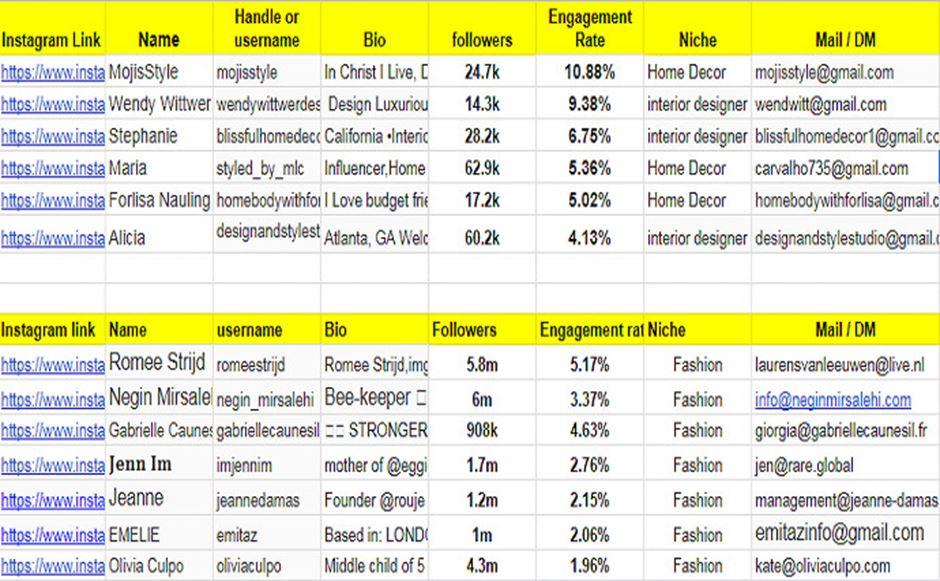
Image source: Fiverr
3) Reach out to them via their collaboration emails, pages or influencer platforms
Next, go one by one through your list and contact influencers with your campaign materials. Also, it’s a good idea to order the names of influencers according to how much they fit into your ideal influencer persona. This way, you will prioritize communication with influencers who are aligned with your brand.
This is the point where you can send them your influencer brief. A good influencer brief contains the following info:
- A bit of background about your company
There’s no need for thousands of words describing what you do. Rather, a tiny description of what you do and what makes you special will suffice. You can also mention if you had any influencer campaigns in the past, how the audience reacted to them and what you liked about it.
- Tell them what you like about them
Next, it’s time to show that you know who they are and that you value their work. You can also talk about how your target audience overlaps with yours. Mention some of the themes and motives they present in their work and be honest and straightforward.
- Outline the campaign
Most importantly, you will have to describe what kind of a campaign you’re planning. Explain its duration, goals, target audience, reach, channels of promotion… If you want, you can already mention the budget you had in mind. Usually, marketers wait for further stages of cooperation and negotiation to talk money matters.
- Be clear about your expectations
It doesn’t matter if you want full control over the campaign or you want to hand over creative freedom to your influencer: either way, you have to communicate exactly what it is that you expect. Define the deliverables that are included in your campaign and the schedule you planned.
If your brief suits the influencer and you reach an agreement for cooperation, it’s time for the campaign to start!
4) Keep in touch before, during and after the campaign
Before you officially start, reach out to your influencer to make sure there aren’t any doubts left unsolved. You can reiterate the deliverables once again as the start time of the campaign approaches. Also, before they publish their materials, you can ask to have them for a pre-review.
During the campaign, you can reach out to them to see how it’s going. Influencers have access to their profile stats, engagement rates with the post and more analytical info. If things are not going as well as you planned, you can sponsor the post with an extra boost to increase its visibility and impression rate.
5) Discuss the results and arrange future collaborations
Finally, after the campaign is done, you can look at the results together in more details and review the entire process. Remember, the influencer you’re working with is an invaluable source of information about their audience, because they have likely been interacting with them for years. If the results didn’t meet your expectations, discuss what could have been improved and ask their opinion on what went wrong. If your results were great, discuss how you can make them even better next time or scale the process to reach even more people.
Now that you have created a line of cooperation, you can continue working with that particular influencer if you’re happy with the results. Remember to add the info about the most recent campaign in your influencer list. Also, you can use the success rate on that campaign to review the influencer in your list and prioritize them (or not) for your future cooperation.
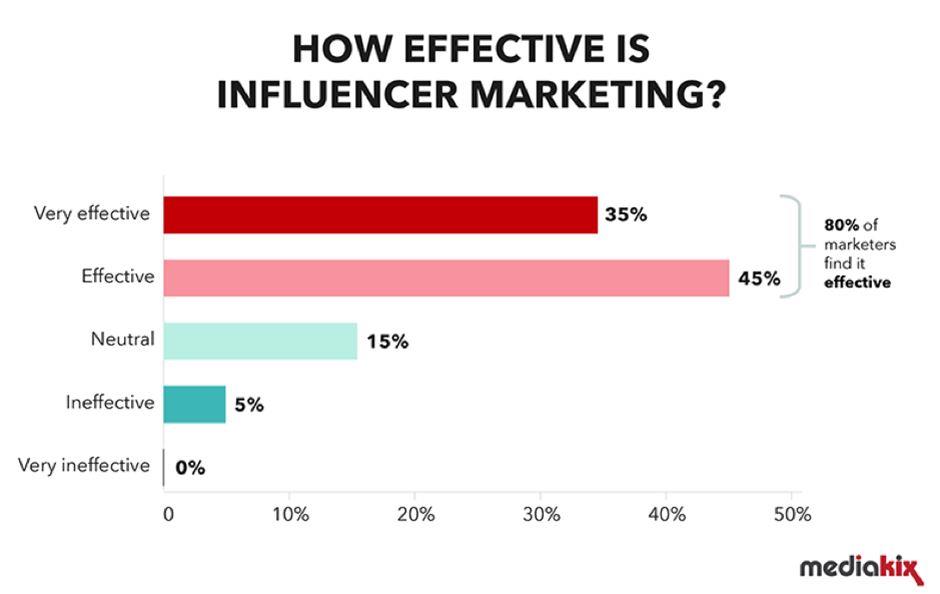
Image source: MediaKix
Generally, 80% of marketers rate influencer campaigns as ‘effective’ or ‘very effective’. What’s even more promising that none of them said they would describe their campaigns as ‘very ineffective’. We hope that you experience the same results!
Conclusion
The best thing about influencer marketing is that it’s a win-win situation for both your brand and the person who will be representing it. You should pick influencers who are relevant for your brand and target audience to reach maximum ROI. Also, you need to do a cost-benefit analysis of whether it’s worth it to invest more in middle and macro-influencers. Keep in mind that nano and micro-influencers often have higher ROI and engagement rates.
Approach influencer campaigns as strategically and carefully as you would any other social media or PPC campaign. Keep your info and insights in order and maintain a list of your favourite influencers and those you are yet to reach out to. Finally, don’t give up – if you get poor results, you should continue tweaking your campaigns!
Have you already worked with influencers in your marketing campaigns? What was your experience like? Tell us more in the comments!
Dorian Martin is a writer, editor and content marketing expert. He helps students who want an expert to write my paper for me. Dorian is especially interested in new digital marketing technologies and online business. He also runs his personal blog, where he posts about entrepreneurship and success.